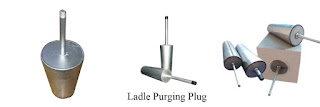The function of the continuous casting tundish
The continuous casting tundish was originally used for the heat preservation of molten steel, and its main purpose was to distribute and rectify molten steel. With the successful development of technologies such as slow cooling of molten steel, molten steel reheating technology, argon gas sealing technology, gas stirring technology and removal of non-metallic inclusions in molten steel, continuous casting tundish have become the most important part of the final stage of the steel smelting process. The main refining vessel is developing to a large scale.
1 Purification function
To produce high-purity clean steel, install porous air-permeable bricks at the bottom of the tundish or embed porous tubular gas distributors between the working layer and permanent layer, or install porous bricks on the slag retaining wall to blow argon to make argon bubbles. Float evenly from the bottom to promote the removal of inclusions. These devices can eliminate the hydrogenation of molten steel in the initial stage of pouring, reduce the oxide inclusions in the molten steel, and reduce the defects caused by AI2O3 inclusions on the tin plate.2 Temperature adjustment function
In order to make the temperature difference of molten steel before, during and after the tundish be less than 5℃ and close to the liquidus temperature during the pouring process, expand the equiaxed crystal area of the casting slab and reduce the center segregation, small scrap steel and iron injection can be adopted to the tundish powder and other measures to adjust the temperature of molten steel.3 component fine-tuning
The central hole of the tundish stopper rod feeds cored wires such as aluminum, titanium, boron, etc. To the mold to realize the fine adjustment of the microalloy composition in the steel, which not only increases the cost of easy oxidation elements, but also avoids nozzle blockage.4 Refining function
Add double-layer slag to the surface of the molten steel in the tundish to absorb the floating inclusions in the molten steel, or feed the calcium wire in the tundish to change the shape of AL203 inclusions to prevent nozzle blockage.5 heating function
In the tundish, induction heating and plasma heating are used to accurately control the molten steel pouring temperature within ±3~5℃. In the initial stage of continuous casting, the tundish heating is used at the end of ladle pouring to compensate for the decrease in molten steel temperature and keep the molten steel temperature near the target. This is conducive to the stability of the pouring operation and improves the quality of the slab. During the pouring period, proper heating can compensate for the natural cooling of molten steel. The heating method uses induction heating and plasma heating.
Article Source:The function of the continuous casting tundish
Company name :Luoyang Wanhao New Material Co., Ltd.
More Refractory Products: http://www.wanhaorefractory.com/en/product.html
Website: http://www.wanhaorefractory.com/


评论
发表评论